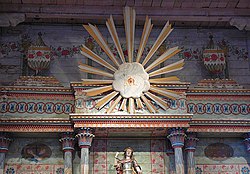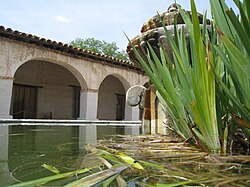Mission San Miguel Arcángel
The mission remains in use as a parish church of the Diocese of Monterey. After being closed to the public for six years due to the 2003 San Simeon earthquake, the church reopened on September 29, 2009. Inside the church are murals designed by Esteban Munras.
The mission was put on the National Register of Historic Places in 1971 and was named to a National Historic Landmark in 2006. Of California's missions, it is one that retains more than most of its layout and buildings, including a portion of its neophyte village.
History

Father Fermín Lasuén and Father Buenaventura Sitjar founded the mission on July 25, 1797, making it the sixteenth California mission. Its location between Mission San Luis Obispo and Mission San Antonio de Padua provided a stop on the trip that had previously taken two days. A temporary wooden church was built with living quarters. The site was chosen as it was close to a Salinan Indian village called Vahca. In 1798 the small chapel was replaced. From 1816 to 1818 a new church was constructed with a tile roof and courtyard.
Mission San Miguel Arcángel land was sold off after the Mexican secularization act of 1833. The William Reed family lived in the buildings until 1848, when they were murdered by a band of thieves. The killers were tracked down by a posse in the foothills of Santa Barbara. Two thieves died in the ensuing battle, and the other three were tried and executed by firing squad. Upon secularization, the mission began to decay. Padre Abella, the last Franciscan at San Miguel, died in July, 1841.
In 1859 the U.S. government returned the mission to the Catholic Church. But with the buildings in poor condition, no priests were assigned to the mission; buildings were rented to some small businesses. In 1878 the Church reactivated the mission, and Rev. Philip Farrelly took up residence as First Pastor of Mission San Miguel. In 1928 the mission was returned to the Franciscan Padres, the same group who had founded the mission in 1797.
Features

- The Mission Arcade, a series of 12 arches, is original. The variety of shapes and sizes was planned and the Mission was known for this arcade.
- The first chapel on the site was replaced within a year of its construction by a larger adobe chapel, which burned in the 1806 fire.
- The current mission church was built between 1816 and 1818. It is 144 feet (44 m) long, 27 feet (8.2 m) wide, and 40 feet (12 m) high.
- The cemetery adjacent to the church holds the remains of 2,249 Native Americans listed in the Mission's burial records.
- The painted walls inside the church are the original artwork by artist Esteban Munras and other Salinan artists.
Mission bells
Bells were vitally important to daily life at any mission. The bells were rung at mealtimes, to call the Mission residents to work and to religious services, during births and funerals, to signal the approach of a ship or returning missionary, and at other times; novices were instructed in the intricate rituals associated with the ringing the mission bells.
Associated structures
The Rios-Caledonia Adobe was built in 1835 just south of the San Miguel Mission as a home for the overseer of Mission lands. This historic site is well preserved with the original Inn and Stagecoach stop now a museum and small gift shop. A building was added in 1930 that is now a unique history research library. The grounds are maintained by San Luis Obispo County Parks with picnic sites and restrooms available.
The Historic Rios-Caledonia Adobe is a California Historical Landmark (#936) and is listed on the National Park Service's National Register of Historic Places (#71000190).
Gallery
-
Mission plaza
-
Ojo de Dios, above altar
-
Adobe wall and bell tower at Mission San Miguel Arcangel
-
Fountain in plaza
See also
- Spanish missions in California
- List of Spanish missions in California
- USNS Mission San Miguel (AO-129) – a Buenaventura Class fleet oiler built during World War II.
- Ygnacio Coronel (1795–1862). In 1836, Coronel was appointed commissioner of the secularized Mission.
- List of National Historic Landmarks in California
Notes
- ^ Leffingwell, p. 91
- ^ Krell, p. 254
- ^ Engelhardt
- ^ Ruscin, p. 129
- ^ Yenne, p. 140
- ^ Ruscin, p. 196
- ^ Forbes, p. 202
- ^ Ruscin, p. 195
- ^ Krell, p. 315: as of December 31, 1832; information adapted from Engelhardt's Missions and Missionaries of California.
- ^ "National Register Information System". National Register of Historic Places. National Park Service. July 9, 2010.
- ^ "Mission San Miguel Arcangel". National Historic Landmark Quicklinks. National Park Service. Archived from the original on January 9, 2013. Retrieved March 20, 2012.
- ^ Grimes, Theresa (May 19, 2005). "Mission San Miguel Arcángel" (pdf). National Register of Historic Places – Inventory Nomination Form. National Park Service. Retrieved May 22, 2012.
- ^ "History". Mission San Miguel. Archived from the original on October 29, 2016. Retrieved December 13, 2016.
- ^ "The Murders in the Old Mission". Retrieved April 2, 2020.
- ^ "Mission San Miguel Arcangel Historical Time Line". Retrieved April 2, 2020.
- ^ "California Missions". Retrieved August 26, 2016.
- ^ "Mission San Miguel Arcàngel: Home of Indigenous Salinan Art". NPS.gov. National Park Service, United States Department of the Interior.
- ^ Grimm, Michele; Grimm, Tom (December 21, 1986). "On a Holiday Mission to San Miguel". Los Angeles Times. Retrieved March 10, 2021.
- ^ "May 1 marks grand opening of Rios-Caledonia Research Library". Paso Robles Daily News. April 28, 2016. Retrieved March 10, 2021.
- ^ "Historic Rios-Caledonia Adobe". The Historic Rios-Caledonia Adobe website. Retrieved March 10, 2021.
- ^ "Rios-Caledonia Adobe". Office of Historic Preservation, California State Parks. Retrieved October 14, 2012.
References
- Coronado, Michael; Ignatin, Heather (June 5, 2006). "Plan would open Prop. 40 funds to missions". The Orange County Register. Archived from the original on March 8, 2009. Retrieved March 8, 2008.
- Engelhardt, Zephyrin, O.F.M. (1931). San Miguel Arcángel: The Mission on the Highway. Mission Santa Barbara, Santa Barbara, CA.
{{cite book}}: CS1 maint: multiple names: authors list (link) - Forbes, Alexander (1839). California: A History of Upper and Lower California. Smith, Elder and Co., Cornhill, London.
- Jones, Terry L.; Klar, Kathryn A., eds. (2007). California Prehistory: Colonization, Culture, and Complexity. Landham, MD: Altimira Press. ISBN 978-0-7591-0872-1.
- Krell, Dorothy, ed. (1979). The California Missions: A Pictorial History. Sunset Publishing Corporation, Menlo Park, CA. ISBN 0-376-05172-8.
- Leffingwell, Randy (2005). California Missions and Presidios: The History & Beauty of the Spanish Missions. Voyageur Press, Inc., Stillwater, MN. ISBN 0-89658-492-5.
- Paddison, Joshua, ed. (1999). A World Transformed: Firsthand Accounts of California Before the Gold Rush. Heyday Books, Berkeley, CA. ISBN 1-890771-13-9.
- Ruscin, Terry (1999). Mission Memoirs. Sunbelt Publications, San Diego, CA. ISBN 0-932653-30-8.
- Yenne, Bill (2004). The Missions of California. Thunder Bay Press, San Diego, CA. ISBN 1-59223-319-8.
External links
- Official web site – Includes an online tour of the mission interior and some exterior
- Indian Life at Mission San Miguel Arcángel via The California Frontier Project
- The founding of Mission San Miguel Arcángel via The California Frontier Project
- Elevation & Site Layout sketches of the Mission proper
- Virtual Reality Panorama "Mission San Miguel"
- Early photographs, sketches, land surveys of Mission San Miguel Arcángel Archived 2008-10-14 at the Wayback Machine, via Calisphere, California Digital Library
- Early History of the California Coast, a National Park Service Discover Our Shared Heritage Travel Itinerary
- Library of Congress, Americas Memory
- Howser, Huell (December 8, 2000). "California Missions (104)". California Missions. Chapman University Huell Howser Archive.




